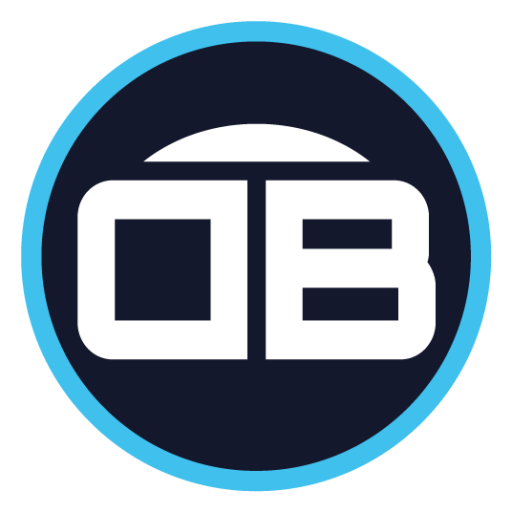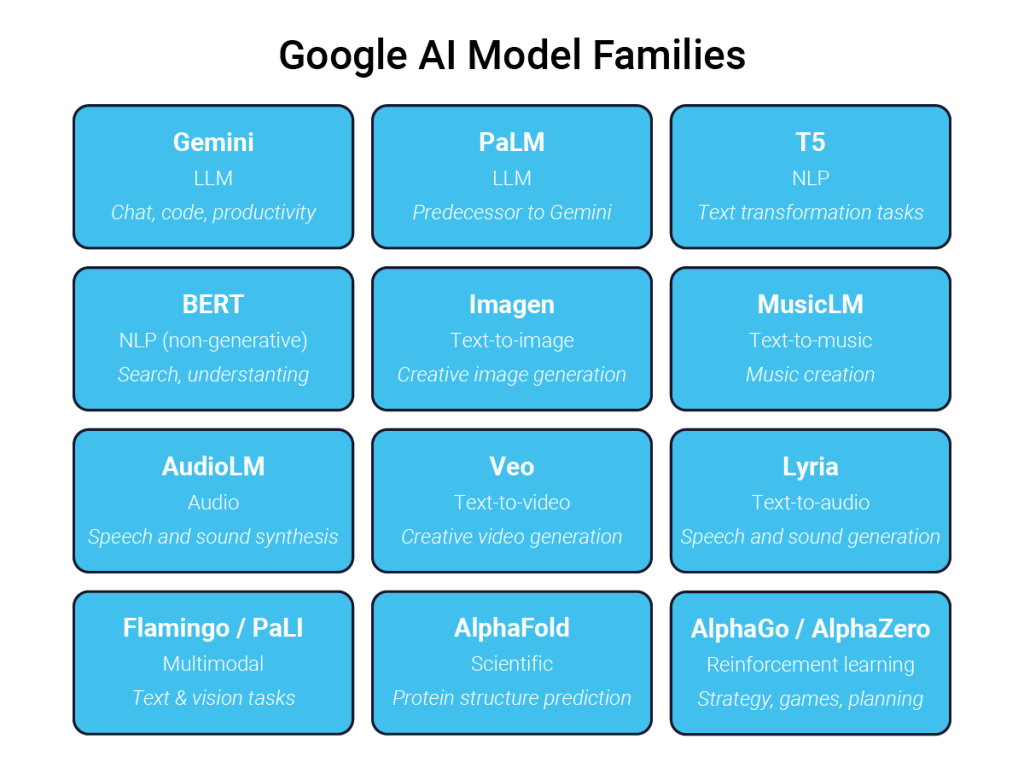Drive innovation with Vertex AI and DeeperThanBlue
There's more to Google Cloud AI than meets the eye
Google’s approach to AI brings solutions to the fingertips of businesses and individuals, and at DeeperThanBlue, we help businesses harness the transformative potential of Google Cloud AI, including the cutting-edge capabilities of Google Gemini and Google Cloud Vertex AI. Whether you’re exploring AI for the first time or scaling existing solutions, our expertise ensures you unlock real business value.
The suite of AI applications available from Google is comprehensive, underpinned by a deep research pedigree and a robust ecosystem of products, platforms, and tools.
Google Cloud AI Suite
Gemini is Google’s flagship family of large language multimodal models that handles everything from natural language processing to creating content across different media types. These models are capable of understanding and generating text, images, audio, video, and code.
Gemini has essentially taken over from earlier models like PaLM, incorporating the latest breakthroughs from Google’s AI labs and DeepMind. You’ll find these models woven throughout Google’s offerings—Search, Gmail, Docs, Android, and Google Cloud—powering features like AI writing assistance, instant translation, and code generation. This isn’t just academic research; it’s AI that’s actually being used by millions.
Supporting Gemini is a suite of specialist models, each with their own functionality. BERT still does the heavy lifting for semantic search and language understanding, particularly in Google Search. Veo, Imagen (used to create the hero image on this page), MusicLM, and AudioLM/Lyria handle the creative side, generating video, images, music, and audio respectively. Then there are multimodal models like Flamingo and PaLI that can work across text, images, and video—the building blocks for truly versatile AI systems. At the cutting edge, DeepMind continues to push boundaries with game-changers like AlphaFold (which cracked protein folding) and AlphaZero (the strategic AI master).
Gemini is designed for flexibility and ease of use, supporting deployments across multiple environments-including multi-cloud and on-premises-making it ideal for businesses seeking agility and avoiding vendor lock-in. Moreover, it integrates easily with existing software stacks, including Salesforce, Trello, and Asana.
The latest version of the Google Gemini family is 2.5, designed for enterprise-grade performance and flexibility. The main variants include:
- Gemini 2.5 Pro: A powerful model for complex reasoning, multimodal understanding, and high-quality content generation. It supports text, image, audio, and video inputs, making it ideal for advanced enterprise use cases like document analysis, media summarisation, and intelligent agents.
- Gemini 2.5 Flash: A high-speed, cost-efficient model optimised for real-time applications. It offers enhanced performance over 1.5 Flash and supports multimodal inputs, function calling, and live API interactions. It’s ideal for chatbots, summarisation, and fast content generation.
- Gemini 2.5 Flash-Lite: A lightweight version of Flash, designed for ultra-low-latency tasks with minimal compute requirements. Best suited for mobile and edge deployments or high-volume, low-complexity tasks.
Vertex AI
Google Cloud Vertex AI is a vital part of Google’s AI hierarchy, but it’s not a model itself. Instead, it acts as the platform layer that gives developers and enterprises access to Google’s models, tools, and infrastructure. It is a unified platform for building, deploying, and scaling machine learning and generative AI models. Think of it as the operational hub where everything AI-related within Google Cloud comes together.
In the hierarchy, Vertex AI sits just below the model layer (like Gemini, Imagen, PaLM, etc.) and above the application or deployment layer. It allows users to build, customise, deploy, and manage machine learning models at scale. You can fine-tune Google’s foundation models (like Gemini Pro or Imagen), run your own custom models, or even integrate open-source ones—all within a unified environment. It also provides MLOps capabilities (pipelines, model monitoring, versioning, etc.), making it particularly powerful for production-grade enterprise use.
In short, Vertex AI is the delivery engine—the platform that makes Google’s models usable in the real world by developers, data scientists, and businesses. It’s how Google’s AI is productised and made available to the public outside of its own first-party apps like Gmail or Search.
There are three components of Vertex AI:
- Vertex AI Agent Builder: Create intelligent, task-specific agents using natural language prompts—ideal for customer service, HR, and IT automation.
- Vertex AI Model Builder: Train and fine-tune custom models using your own data, with support for AutoML and custom training.
- Vertex AI Model Garden: Access a curated library of pre-trained models, including Gemini, open-source models, and third-party offerings.
Why Choose DeeperThanBlue for Google Cloud AI?
With over 20 years’ experience in IT and digital transformation, DeeperThanBlue delivers tailored AI solutions that align with your business goals. We help you navigate the complexities of Google Cloud AI, from strategy and integration to ongoing support.
Ready to explore Google Gemini and Vertex AI for your business? Contact DeeperThanBlue today to start your AI journey.
+44 (0)114 399 2820
info@deeperthanblue.com
Get in touch
Google Cloud AI FAQs
What is Google Cloud AI?
Google Cloud AI refers to a suite of tools, APIs, and services offered through Google Cloud that enable businesses to build, train, deploy, and manage artificial intelligence and machine learning models. It includes everything from pre-trained APIs for vision, speech, and language to custom model development via Vertex AI.
How can Google Cloud AI be integrated into my business?
Google Could AI includes pre-built connectors for Google Workspace, BigQuery, Looker, Cloud Storage and other Google products. It is possible to connect to third-party platforms (such as Salesforce, SAP and ServiceNow) via APIs and SDKs, and to custom enterprise systems using RESTful APIs and SDKs in Python, Java, and more.
DeeperThanBlue can assist with the implementation of these integrations.
Where could I use Google Cloud AI?
Google Cloud AI technologies are transforming industries. Here are just a few ways businesses are using Gemini and Google Cloud Vertex AI:
- Retail & eCommerce: Personalised product recommendations, intelligent chatbots for customer service and support, and demand forecasting.
- Financial Services: Fraud detection, document summarisation, and customer support automation.
- Healthcare: Medical imaging analysis, patient triage bots, and clinical documentation.
- Manufacturing: Predictive maintenance, quality control, and supply chain optimisation.
- Professional Services: Knowledge management, proposal generation, and internal process automation.
Its flexibility makes it suitable for both SMEs and large enterprises.
How much does Google Gemini and Google Cloud Vertex AI cost?
Pricing for Gemini is based on token usage and varies by model and context length. As of August 2025, pricing for Gemini 2.5 Pro and Gemini 2.5 Flash was:
Gemini 2.5 Pro
- Input (text, image, video, audio, code): $1.25 per 1M tokens for prompts of 200k tokens or less; $2.50 per 1M tokens for prompts of more than 200k tokens.
- Output (both thinking and non-thinking): $10 per 1M tokens for prompts of 200k tokens or less; $15 per 1M tokens for prompts of more than 200k tokens.
Gemini 2.5 Flash
- Input (text, image, video): $0.30 per 1M tokens
- Audio Input: $1 per 1M tokens
- Output (both thinking and non-thinking):
- Text: $2.50 per 1M tokens
- Audio: $12 per 1M tokens
Gemini Live API is designed for real-time interactions, particularly with audio. The pricing is structured differently from the standard API:
Input Costs:
- Text: $0.50 per 1 million tokens
- Audio / Image: $3.00 per 1 million tokens
Output Costs:
- Text: $2.00 per 1 million tokens
- Audio: $12.00 per 1 million tokens
Note: Prices may vary depending on usage volume and context length (e.g., >200K tokens may incur higher rates).
Vertex AI is available on a pay-as-you-go basis for training, deployment and predictions. There is no minimum usage duration.
What is a token?
A token is a chunk of text. It can be:
- A word (e.g., “apple” = 1 token)
- Part of a word (e.g., “unbelievable” = 2–3 tokens)
- Punctuation or whitespace (e.g., “.” or ” ” = 1 token)
On average:
- 1 token ≈ 4 characters of English text
- 1 token ≈ ¾ of a word
- 100 tokens ≈ 75 words
Take the example of a page of A4 filled with English text 12 point font at 1.5 line spacing. There would be an average of 5000 and 700 words on this page, depending on formatting and content density. Asking a AI tool to process this document would ‘cost’ between 650 and 900 tokens which, when using Gemini 2.5 Flash, would equate approximately $0.0001.
If we then wanted to take this analysed input to create a 30s audio summary and 3 LinkedIn posts, the output would use around 1,200 tokens, equating to around $0.003.
How does Google Cloud AI ensure the security of business data?
Google Cloud AI uses multiple layers of security, including end-to-end encryption (in transit and at rest), customer-managed encryption keys, and advanced threat detection powered by AI and machine learning. Security controls such as VPC Service Controls, Identity-Aware Proxy, and Confidential Computing help businesses maintain strict control over sensitive data.
How does Google Cloud AI handle data privacy and compliance?
Google Cloud adheres to industry-leading security and privacy standards, including ISO/IEC certifications, GDPR, HIPAA, and SOC compliance. Data used to train or infer with models on Google Cloud remains under the customer’s control, and encryption is applied both in transit and at rest.
Can I bring my own machine learning model to Google Cloud?
Yes. Google Cloud fully supports custom model development. You can train your own models using frameworks like TensorFlow, PyTorch, or scikit-learn, and deploy them on Vertex AI for scalable inference, version control, and monitoring.
How do I get started with Google Cloud AI?
To begin, sign up for a Google Cloud account and activate Vertex AI in your console. Google offers generous free-tier credits and guided tutorials to help you get started quickly. For enterprise needs, consider engaging a Google Cloud Partner, like DeeperThanBlue, we can help you get approved for Cloud credits and improved pricing and commercial options, for tailored onboarding.



